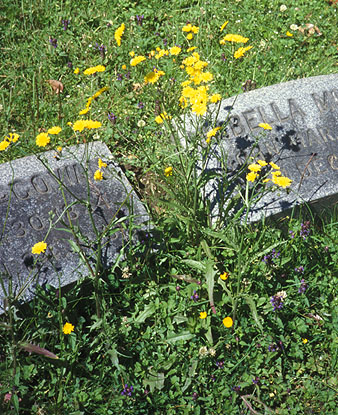
|
| Smooth Hawk's-beard; Crepis capillaris (L.) Wallr. |
Sunflower Family; COMPOSITÆ (ASTERACEÆ)
|
| At least 20 yellow-flowered dandelion relatives are weedy in Seattle. Ten have already had their mug shots featured in this
newsletter, Hawk's-beard is eleventh, and one year from now will be the last (Hawkbit). In fact it will be the 100th weed, and thereafter
the columns can repeat themselves. |
| Because there are so many dandelion lookalikes, people get confused trying to learn them. It doesn't help that three
have Hawk in their names: Hawk's-beard, Hawkbit and Hawkweed. Nor have I learned of any good reason or interesting explanation
for their "hawk-ness." The Scientific name
Crepis is based on an ancient Greek name of a plant, the word meaning a boot. Again,
no rationale is known. |
| Smooth Hawk's-beard blooms from mid-May into September. It can be an annual, biennial or perennial. Each
plant produces several much-branched flower stems, each of which bears a hundred or two flowers, each flower of which bears dozens
of seeds. The flowers are dandelion-yellow, but smaller. Ditto with the seed puffballs. The leaves are shredded into lacy fringes,
and devoid of hairiness. The whole plant grows 2 to 3 feet tall. By late summer its stems often turn purplish or red, but the same
thing happens on some of its cousins. |
It cannot stand being mowed, unlike its cousins Cat's-Ear
(Hypochæris) and Dandelion
(Taraxacum). It dislikes desert-like dry conditions, as well as shade. It prefers edges of woods, and meadow-like grassy patches that are rarely mowed. Compared
to Sowthistle (Sonchus), Nipplewort
(Lapsana), and many other yellow-flowered weeds, it is not as common. In western Oregon,
the related Bristly Hawkbeard (Crepis
setosa) is common; but I have found it only twice in Seattle.
|
Originally published as the Seattle Tilth newsletter Weed of the Month in August 1994, along with an illustration from a book.
Back |
|
|

